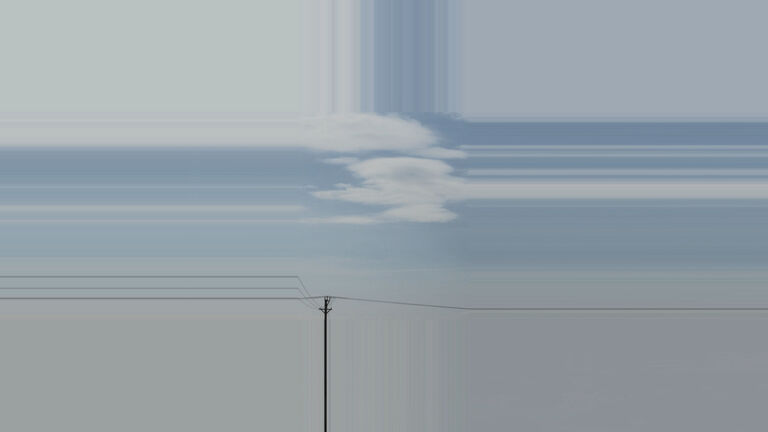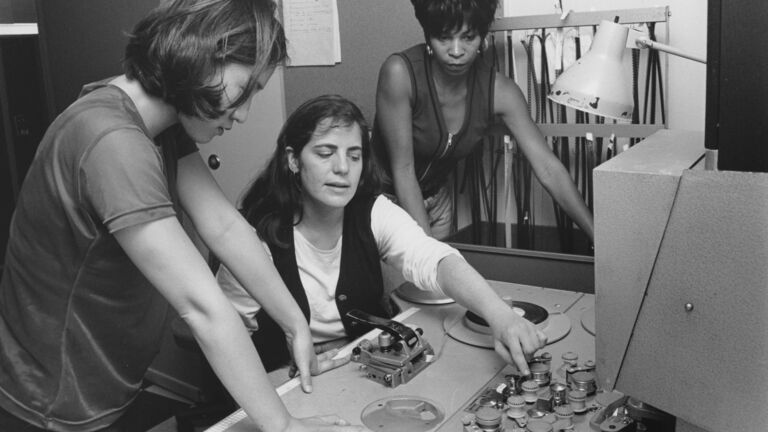
Cecilia Tyrrell, "Sirens Dawn"
Undergraduate Overview
Film, Video, New Media, and Animation Undergraduate Overview
As a Bachelor of Fine Arts in Studio (BFA) student studying in the Department of Film, Video, New Media, and Animation (FVNMA), you will have access to state-of-the-art filming, editing, and production equipment plus a large, diverse list of course offerings to address your individual artistic needs.
The FVNMA department reaches beyond conventional approaches of moving image media and animation programs. Students concentrating their studies in FVNMA at SAIC investigate the possibilities of:
- Nonfiction/documentary and narrative film and video
- Moving-image installation
- Hand-drawn and digital 2D and 3D animation
- Interactive art, VR, AR, and web-based projects
- Media art histories
FVNMA students often invent interdisciplinary pathways to produce hybrid works that expand traditional forms to create new avenues of expression—acts of artistic exploration and risk-taking that the department enthusiastically supports.
The work of FVNMA faculty is represented in museums and galleries; presented at major international festivals of film and media; screened in art cinemas and at music and performance venues; embraced in community-based projects; and featured in prominent arts publications. Students take classes offered by these working practitioners, as well as with faculty across all departments, to develop and focus their own unique creative approaches. It is through this process that students learn to research, invent, and explore. The seminars, production classes and innovative art history offerings ensure that students receive in-depth knowledge of theories and histories relevant to moving-image art making.
Studio courses follow disciplinary paths of cinema, video art, new media art, and animation—experimental 3D and 2D. These classes provide rigorous technical training through sequences in each path that advance practical and critical skills, connecting your work to wider interdisciplinary concerns. Courses engage historical, critical, aesthetic, cultural, and technological issues by making experimental media art.
The program is consistently ranked among the top five graduate Film/Animation Schools in the nation by U.S. News and World Report.
Undergraduate Admissions Requirements & Curriculum Overview
Use the accordions (+) below to learn more about the admissions requirements and curriculum.
-
To apply to the School of the Art Institute of Chicago (SAIC), you will need to fill out an application and submit your transcripts, artist's statement, and letters of recommendation. And most importantly, we require a portfolio of your best and most recent work—work that will give us a sense of you, your interests, and your willingness to explore, experiment, and think beyond technical art, design, and writing skills.
To apply, please submit the following items:
Bachelor of Fine Arts in Studio Portfolio
Submit 10–15 pieces of your best and most recent work. We will review your portfolio and application materials for merit scholarship once you have been admitted to SAIC.When compiling a portfolio, you may concentrate your work in a single discipline or show work in a breadth of media. The portfolio may include drawings, prints, photographs, paintings, film, video, audio recordings, sculpture, ceramics, fashion designs, graphic design, furniture, objects, architectural designs, websites, video games, sketchbooks, scripts, storyboards, screenplays, zines, or any combination of the above.
Learn more about applying to SAIC's Bachelor of Fine Arts in Studio, or view our portfolio preparation guide for more information.
-
Studio
69
- CP 1010 Core Studio Practice I (3)
- CP 1011 Core Studio Practice II (3)
- CP 1020 Research Studio I (3)
- CP 1022 Research Studio II (3)
- SOPHSEM 2900 (3)
- PROFPRAC 3900 (3)
- CAPSTONE 4900 (3)
- Studio Electives (48)
PROFPRAC and CAPSTONE are now required for new incoming students beginning in the 2015-16 academic year.
Art History
15
- ARTHI 1001 World Cultures/Civilizations: Pre-History—19th Century Art and Architecture (3)
- Art History Elective at 1000 level (3)
- Art History Electives (9)
Liberal Arts
30
- ENGLISH 1001 First Year Seminar I (3)
- ENGLISH 1005 First Year Seminar II (3)
- Natural Science (6)
- Social Science (6)
- Humanities (6)
- Liberal Arts Electives (6)
General Electives
6
- Studio, Art History, Liberal Arts, AAP, or EIS
Total Credit Hours
120
* BFA students must complete at least 6 credit hours in a class designated as "off campus study." These credits can also fulfill any of the requirements listed above and be from any of the divisions (Art History, Studio, Liberal Arts, or General Electives).
BFA With Distinction—SAIC Scholars Program:
The SAIC Scholars program is a learning community of BFA students pursuing rigorous study in both their academic coursework and their studio pathways. There are two opportunities for interested students to apply to the SAIC Scholars Program: at the time of admission to the school, and after they have completed 30 credits of study at SAIC. Students pursuing the latter option are required to formally submit an application to the Undergraduate Division. Once admitted to the SAIC Scholars Program, students are required to successfully complete a minimum of six designated scholars courses. Students who complete the program will graduate with distinction.
BFA in Studio with Thesis Option (Liberal Arts or Visual Critical Studies)
BFA students may complete a nine-credit, research-based academic thesis as part of their studies within the 126 credits for the BFA in Studio degree. BFA with Thesis course sequences are offered over 3 semesters through the departments of Liberal Arts or Visual and Critical Studies (VCS). Students who are interested in one of the thesis options should follow the steps outlined below in the beginning of the junior year.
Requirements for the BFA: Studio Art with Liberal Arts Thesis
Step One: Students are required to meet with the Chair of the Liberal Arts department in the beginning of their junior year.
Step Two: With the Department Chair's approval, the student enrolls in the following courses beginning in the spring term of their junior year:
- SOCSCI or HUMANITY 3900 Academic Research and Writing (3 credits)
- LIBARTS 4800 Undergraduate Thesis: Research/Writing I (3 credits)
- CAPSTONE 4900 Liberal Arts Undergraduate Thesis: Research/Writing II (3 credits)
Step Three: The completed thesis must be approved by both the Thesis II instructor and the Chair of Liberal Arts. Students must make a formal presentation and participate in the Undergraduate Thesis Symposium in their senior year.
Requirements for the BFA: Studio Art with Visual and Critical Studies (VCS) Thesis
Step One: Students are required to meet with the Visual and Critical Studies Undergraduate Coordinator in or by the beginning of their junior year.
Step Two: With the VCS Coordinator's approval, the student enrolls in the first of the three-course sequence beginning in the spring term of their junior year:
- VCS 3010 Tutorial in Visual & Critical Studies (3 credits)
- VCS 4800 Undergraduate Thesis Seminar: Research & Writing I (3 credits)
- CAPSTONE 4900 VCS Undergraduate Thesis Seminar: Research & Writing II (3 credits)
Step Three: Completion of thesis must be approved by both the Thesis II instructor and the VCS Undergraduate Coordinator. Students must make a formal presentation and participate in the Undergraduate VCS Thesis Symposium in the senior year.
Total credits required for minimum residency
66
Minimum Studio credit
42
Course Listing
